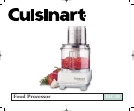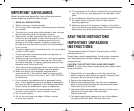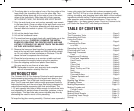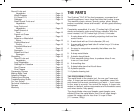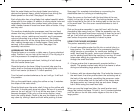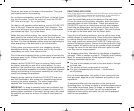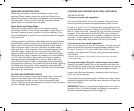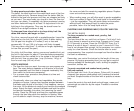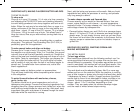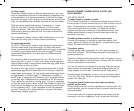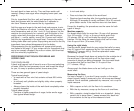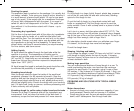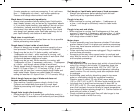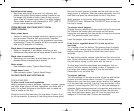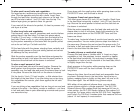
8
To chop parsley and other fresh herbs
The herbs, the work bowl and the metal blade must all be thor-
oughly clean and dry. Remove stems from the herbs. Add the
leaves to the bowl and process until they are chopped as finely
as you want. The more herbs you chop at a time, the finer tex-
ture you can obtain. If completely dry when processed, parsley
and other herbs will keep for at least 10 days stored in an air-
tight bag in the refrigerator. They may be stored frozen for
months in an airtight container or bag.
To chop peel from citrus fruit or to chop sticky fruit like
dates and raisins, add sugar or flour.
For citrus, remove the peel with a vegetable peeler. Leave the
white part on the fruit; this is the pith, which is bitter tasting.
Cut the peel into lengths of 2 inches (5 cm) or less and
process with 1/2 cup (100 g) of sugar until finely chopped.
(This may take a long time – 2 minutes or longer, depending
on how fine you want the peel.)
For sticky fruit like dates, raisins, prunes and candied fruit, put
the fruit in the freezer for about 10 minutes before processing.
Add some of the flour called for in the recipe to the work bowl
with the fruit. Use no more than 1 cup (5 ounces, 140 g) of
flour for each cup (240 ml) of fruit.
WORTH KNOWING
• The finer the chop you want, the more you can process at a
time. The exact amount depends on the texture of the food.
Pulse repeatedly until the food is chopped moderately fine,
then switch to continuous processing.
•
For a coarse chop, process a few pieces at a time and
check texture often.
•
Occasionally, when you chop hard vegetables like carrots,
potatoes or turnips, a piece may become wedged between
the blade and the side of the bowl. If that happens, remove
the cover, lift the blade out carefully and remove the wedged
piece. Empty the bowl, reinsert the blade and lock the cover
and pusher assembly into place, first removing the small
pusher. Press the ON lever and drop the vegetable pieces
through the feed tube while the machine is running. After
you’ve added a cupful this way, stop the machine, remove
the cover and add the remaining vegetable pieces.
Replace
cover and continue processing.
•
When making soup, you will often want to purée vegetables
that have cooked in liquid. Don’t add liquid to the work bowl
– just the vegetables. They will purée faster and smoother
without liquid. Add enough liquid to make the purée
pourable, return it to the soup liquid and stir.
CHOPPING AND PURÉEING MEAT, POULTRY AND FISH
THE METAL BLADE
To chop uncooked or cooked meat, poultry, fish
and seafood
The food should be very cold, but not frozen. Cut it into 2 inch
(5 cm) pieces to ensure an even chop. Process up to 5 cups
(2-1/2 pounds) at a time. Press the PULSE/OFF lever 3 or 4
times at a rate of about 1 second on and 1 second off. If the
food is not chopped fine enough, let the processor run continu-
ously for a few seconds. Check the texture often to avoid
overprocessing. Use a spatula to scrape food from the sides of
the bowl as necessary.
Remember, you control the texture by the length of time you
process. By varying processing time, you can get a range of
textures suitable for hamburgers, hash, stuffing for peppers,
cannelloni, tortillas, etc.
To purée uncooked and cooked meat, poultry,
fish and seafood
Cut the food into 2-inch (5 cm) pieces. Pulse until it is evenly
chopped, then process continuously until it reaches the texture
you want. Scrape the sides of the bowl with a spatula as neces-
sary.
Leave the purée in the work bowl and add eggs, cream and
seasonings as called for by the recipe. Process to combine
thoroughly.



